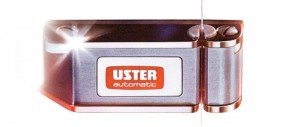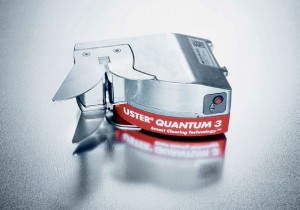 At the push of a button, spinners today can set up automatic yarn clearing with the latest USTER® QUANTUM 3. This amazing feature is the legacy of 50 years’ continuous progress in textile quality assurance and mill optimization. It is a history with three vital elements: USTER’s in-house expertise in instrument technology, detailed knowledge of customers’ quality needs, and – most importantly – the commitment and skill of the USTER people behind some of the textile industry’s most significant innovations. Some of these pioneers, true experts in textile quality control, now help to put these developments in context. Peter Hättenschwiler recalls his early days at USTER, as he was completing his apprenticeship: “My boss told me ‘you can stay with the company if you behave well’ – so that’s what I did.” That was in 1948, and USHättenschwiler went on to devote his entire working life to USTER, playing a key role in many landmark advances. As an apprentice, he assembled the USTER® GGP, the first evenness tester. Later he was in charge of customer service and for many years the head of the Textile Laboratory. Today, at the age of 88, he is still in good shape mentally and physically and can look back on a fulfilling career. The launch of USTER’s first yarn clearer for automatic winders, in 1965, was a special milestone, says Hättenschwiler: “This was at a time when USTER had an outstanding world-leading position as a machine manufacturer because of two important factors. Firstly, we could successfully combine mechanical and electronic know-how, to produce instruments with unique functions. Secondly, the company knew which quality parameters were important to measure and what the spinners wanted.”
At the push of a button, spinners today can set up automatic yarn clearing with the latest USTER® QUANTUM 3. This amazing feature is the legacy of 50 years’ continuous progress in textile quality assurance and mill optimization. It is a history with three vital elements: USTER’s in-house expertise in instrument technology, detailed knowledge of customers’ quality needs, and – most importantly – the commitment and skill of the USTER people behind some of the textile industry’s most significant innovations. Some of these pioneers, true experts in textile quality control, now help to put these developments in context. Peter Hättenschwiler recalls his early days at USTER, as he was completing his apprenticeship: “My boss told me ‘you can stay with the company if you behave well’ – so that’s what I did.” That was in 1948, and USHättenschwiler went on to devote his entire working life to USTER, playing a key role in many landmark advances. As an apprentice, he assembled the USTER® GGP, the first evenness tester. Later he was in charge of customer service and for many years the head of the Textile Laboratory. Today, at the age of 88, he is still in good shape mentally and physically and can look back on a fulfilling career. The launch of USTER’s first yarn clearer for automatic winders, in 1965, was a special milestone, says Hättenschwiler: “This was at a time when USTER had an outstanding world-leading position as a machine manufacturer because of two important factors. Firstly, we could successfully combine mechanical and electronic know-how, to produce instruments with unique functions. Secondly, the company knew which quality parameters were important to measure and what the spinners wanted.”
USTER’s first clearer for automatic winding
The USTER® AUTOMATIC UAM B1 was the first yarn clearer for automatic winders, introduced to the market exactly 50 years ago. It was initially installed on several of the leading automatic winding machine brands of the day, including the Schlafhorst Autoconer AC 107, Gilbos
Conematic, Müller Automat, Barber Colman CC, Schweiter CA11 and Leesona Uniconer. This was actually a further development of the much-earlier USTER `slub catcher´, effectively the original yarn clearing system, which had been patented as ‘Yarn Cleaning Device’ as far back as 1952 and launched on to the market in 1955. The next clearer model for automatic winding, the USTER® AUTOMATIC UAM CI, was launched in 1970. This system added a special `thin place adapter´ to eliminate any disturbing thick and thin places remaining in the yarn. Its development prompted this comment from Hans Locher: “The electronic clearer of today is no longer the simple slub-catcher of yesterday – it is, in fact, an extremely complicated measurement and control instrument.” Locher was writing as Senior Executive Vice President of the then Zellweger Uster company in a customer publication in 1974.
Data systems and microprocessors
In 1975, data became simply essential. USTER was ready with the new USTER® ACTIVITY RECORDER for its latest yarn clearers. This system registered the cut and downtime history of an USTER® AUTOMATIC clearer installation. As such, it was the first true data system for yarn clearers – the precursor of modern systems now regarded as indispensable in yarn clearing. The USTER® POLYMATIC UPM 1 was the first of the company’s clearers to be based on microprocessors. Marketed in 1985, a further innovation was its use of the NSLT classification, still important today. Responsible for its development was Kurt Aeppli, today retired and in good health at the age of 75. He says: “The microprocessor technology came from the United States and we were glad to get it as it opened new possibilities for yarn clearing.” The ability to detect and remove disturbing foreign matter contamination in yarn was a valuable innovation for spinners, and USTER added this feature after taking over the operations of Peyer AG in 1994. The USTER® PEYER CLEARER UPC 200 was the first USTER® y arn clearer a ble to detect foreign fibers. It had a unique design, based on an optical sensor which could pinpoint disturbing thin places, thick places and foreign fibers simultaneously. “Meeting the needs of the customers was the big driver for my colleagues and me in product development. We were also
highly-motivated to share our experience in on-site training sessions,” says Peter Haldemann, who worked as an Application Engineer within USTER for 13 years and who today is retired at the age of 74.
The USTER® QUANTUM era
Yarn clearing in the past had largely been based on the ‘class’ approach, in which the customer selected category fields required to be free of defects. USTER® QUANTUM was the first yarn clearer to allow active monitoring of quality parameters at the winder and to introduce the scatter plot method to the process. This revolutionary system, displaying real yarn events (irregularities), was implemented in the first and second generations of the USTER® QUANTUM. Here it is worth noting that a total of 2.2 million USTER® QUANTUM units were sold before the next generation was launched. Today’s third generation, the USTER® QUANTUM 3, incorporates another revolutionary step forward, with the YARN BODY concept. This is a new visual parameter – effectively presenting a ‘picture’ of the yarn and its quality characteristics. This feature works alongside USTER’s SMART CLEARING TECHNOLOGY – a unique facility which allows users to determine all the required clearer settings at the push of a button. The integral Smart Limit system then suggests optimum clearing limits based on the YARN BODY. “Although the YARN BODY and Smart Limits have been termed visionary and ground-breaking, in reality these innovations are actually built on the ingenious foresight of many USTER experts over the years,” says Sivakumar Narayanan, Head of Product Management within Uster Technologies.
The 50th anniversary
Reviewing 50 years of USTER’s history of yarn clearing for automatic winders is a classic product success story. It demonstrates the continuing and sustainable development of a major product line, and reminds us that important previous stages of development still feature in the current generation of the USTER® QUANTUM 3. In the past 50 years, a total of 15 yarn clearer models were introduced to the market. But it is not only about the innovative features invented over this period, but also the continuing trust shown by spinners, relying on these yarn clearers to safeguard the quality of their entire yarn production – essentially their reputation. In fact, the real credit for this success belongs not to the company, but to the people behind these ground-breaking developments. “The remarkable history of the yarn clearers, as well as of the company, is strongly related to the total dedication of the staff, in the past and still today, and particularly to the unique ability of our engineers to combine both evolutionary developments and revolutionary innovations,” says Dr. Geoffrey Scott, CEO of Uster Technologies. “From Peter Hättenschwiler’s ‘good behaviour’ as an apprentice, and the commitment of many others over the years, USTER has built its position as a global leader for quality testing and monitoring systems.”
 Tekstil Teknik Dergisi Tekstil Haberleri, Tekstil Sektörü, Tekstil Teknik
Tekstil Teknik Dergisi Tekstil Haberleri, Tekstil Sektörü, Tekstil Teknik




